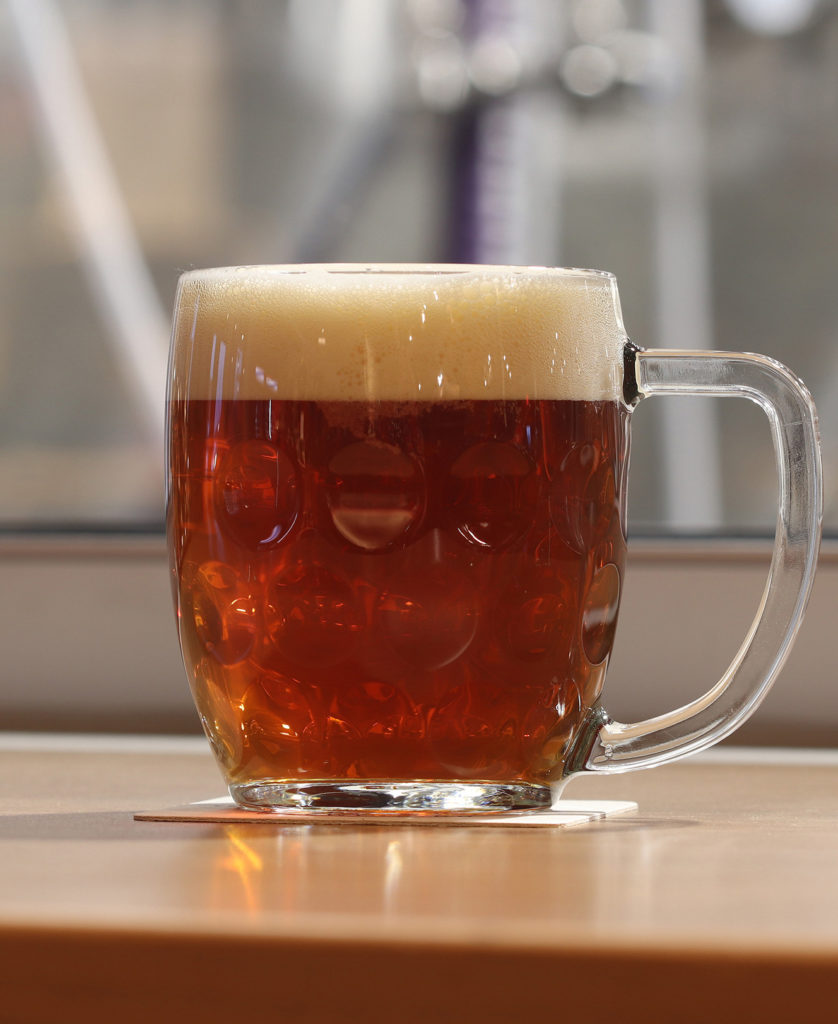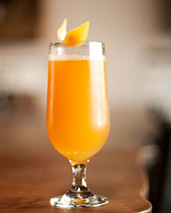Märzen

Bready
Crisp
Esters
Herbal
Straw
Gold
Amber
Dark Amber
Brown
Black
Straw
Black
Gold to Amber / 8 – 17 SRM
Very Low
Low
Moderate
Pronounced
Assertive
Highly Assertive
Very Low
Highly Assertive
Low / 18 – 24 IBU
0%
3%
6%
9%
12%
15%
0%
3%
6%
9%
12%
15%
ABV 5.8 – 6.3% (OG 1.054 – 1.060 with FG 1.010 – 1.014)
Low (Dry)
Medium
High
Low (Dry)
Medium
High
Sweetness Low
Malty
Balanced
Hoppy
Malty
Balanced
Hoppy
Balanced Toward Malt
HISTORY
First brewed at the Spaten brewery in Munich in 1841, Märzen (“March beer”) follows a long tradition of beers brewed to reflect or follow the changing seasons. On English country estates, for example, stronger ales called “March” and “October” beer were named after the months in which they were brewed. In Wallonia (a region situated in modern-day northern France and Belgium), Biere de Mars was brewed with the finest ingredients from the year’s harvest before brewing ceased for the winter and drank the following March. Märzen was created in exactly the opposite way: brewed in March to be lagered over the summer and drank in the cool fall.
Before commercial refrigeration was implemented in brewing (Spaten was the first in 1873), brewers had various ingenious ways of keeping beer cold for lagering, just one of which was a structure built to hold a block of ice one floor above barrelled beer which was kept at the desired temperature by surrounding ductwork that the brewers could manipulate with gates. While the brewers at Spaten likely had similar methods to artificially cool lagering beer, one of the earliest (and easiest) ways to accomplish this was to make stronger beer–which needs to lager longer–in March that would lager in cool cellars over the summer so that it was ready in the cooler fall months. Tradition may also have played a role in this style’s creation. Of the many laws and taxes that shaped brewing practices, an edict from 1553 prohibited brewing between April 24 and September 28. If brewers wanted a stronger beer to be ready for the fall, but also wanted it to lager for a lengthy period, they needed to brew it before the ban kicked in.
Märzen is probably best known to Americans as the beer often labeled “Oktoberfest.” While that was true for over a century–it was first served at the fairgrounds in Munich in 1873–the official beer at Oktoberfest now is Festbier, a lighter-colored cousin of Märzen. Here in the states, craft brewers often still have an “Oktoberfest” offering in the fall months that usually fits in the Märzen style range (but we like to think of it as a year-round brew).
CLASSIC CHARACTERISTICS:
Aroma – Toasty and bready, sometimes with notes of biscuit or graham cracker.
Appearance – Amber, Crystal Clear, Medium-High head with good retention.
Flavor – Very malty without being sweet
Mouthfeel – Medium body with medium carbonation.
Vitals – 5.8 – 6.3% ABV, 8 – 17 IBU
Service Notes:
Serve in a stein at 38ºF
BJCP DESIGNATION: 6A, Märzen
Overall Impression:
An elegant, malty German amber lager with a clean, rich, toasty and bready malt flavor, restrained bitterness, and a dry finish that encourages another drink. The overall malt impression is soft, elegant, and complex, with a rich aftertaste that is never cloying or heavy.
Aroma:
Moderate intensity aroma of German malt, typically rich, bready, somewhat toasty, with light bread crust notes. Clean lager fermentation character. No hop aroma. Caramel, dry-biscuity, or roasted malt aromas inappropriate. Very light alcohol might be detected, but should never be sharp. Clean, elegant malt richness should be the primary aroma.
Appearance:
Amber-orange to deep reddish-copper color; should not be golden. Bright clarity, with persistent, off-white foam stand.
Flavor:
Initial malt flavor often suggests sweetness, but finish is moderately-dry to dry. Distinctive and complex maltiness often includes a bready, toasty aspect. Hop bitterness is moderate, and the hop flavor is low to none (German types: complex, floral, herbal, or spicy). Hops provide sufficient balance that the malty palate and finish do not seem sweet. The aftertaste is malty, with the same elegant, rich malt flavors lingering. Noticeable caramel, biscuit, or roasted flavors are inappropriate. Clean lager fermentation profile.
Mouthfeel:
Medium body, with a smooth, creamy texture that often suggests a fuller mouthfeel. Medium carbonation. Fully attenuated, without a sweet or cloying impression. May be slightly warming, but the strength should be relatively hidden.
Comments:
Modern domestic German Oktoberfest versions are golden – see the Festbier style for this version. Export German versions (to the United States, at least) are typically orange-amber in color, have a distinctive toasty malt character, and are most often labeled Oktoberfest. American craft versions of Oktoberfest are generally based on this style, and most Americans will recognize this beer as Oktoberfest. Historic versions of the beer tended to be darker, towards the brown color range, but there have been many ‘shades’ of Märzen (when the name is used as a strength); this style description specifically refers to the stronger amber lager version. The modern Festbier can be thought of as a pale Märzen by these terms.
History:
As the name suggests, brewed as a stronger “March beer” in March and lagered in cold caves over the summer. Modern versions trace back to the lager developed by Spaten in 1841, contemporaneous to the development of Vienna lager. However, the Märzen name is much older than 1841; the early ones were dark brown, and in Austria the name implied a strength band (14 °P) rather than a style. The German amber lager version (in the Viennese style of the time) was first served at Oktoberfest in 1872, a tradition that lasted until 1990 when the golden Festbier was adopted as the standard festival beer.
Characteristic Ingredients:
Grist varies, although traditional German versions emphasized Munich malt. The notion of elegance is derived from the finest quality ingredients, particularly the base malts. A decoction mash was traditionally used to develop the rich malt profile.
Style Comparison:
Not as strong and rich as a Dunkles Bock. More malt depth and richness than a Festbier, with a heavier body and slightly less hops. Less hoppy and equally malty as a Czech Amber Lager.
Vital Statistics:
OG: 1.054 – 1.060
FG: 1.010 – 1.014
ABV: 5.8 – 6.3%
IBUs: 18 – 24
SRM: 8 – 17
Commercial Examples:
Buergerliches Ur-Saalfelder, Hacker-Pschorr Original Oktoberfest, Paulaner Oktoberfest, Weltenburg Kloster Anno 1050
BA DESIGNATION: German-Style MÄRZEN
- Color: Pale to reddish-brown
- Clarity: Appearance should be clear. Chill haze should not be present.
- Perceived Malt Aroma & Flavor: Bready or biscuity malt aroma and flavor should be present. Sweet maltiness is medium-low to medium and leads to a muted clean hop bitterness. Malt flavors should be of light toast rather than strong caramel. Low level caramel character is acceptable.
- Perceived Hop Aroma & Flavor: Hop aroma and flavor is low with attributes typical of noble hop varieties.
- Perceived Bitterness: Medium-low to medium
- Fermentation Characteristics: Fruity esters and diacetyl should not be present.
- Body: Medium.
- Additional Notes: More toasted and bread crust notes than a festbier. Less hoppy than an Amber Czech Lager.
Original Gravity (°Plato) 1.050-1.060 (12.4-14.7 °Plato)
Apparent Extract/Final Gravity (°Plato) 1.012-1.020 (3.1-5.1 °Plato)
Alcohol by Weight (Volume) 4.0%-4.7% (5.1%-6.0%)
Bitterness (IBU) 18-25
Color SRM (EBC) 4-15 (8-30 EBC)
STYLE COMPARISON:
More toasted and bread crust notes than a festbier. Less hoppy than an Amber Czech Lager.
INGREDIENTS:
- Munich malt base
- Bavarian lager yeast
- German noble hops
BREWING PROCESS:
Traditionally a decoction mash schedule is used to help with modification–munich malt has less capacity to break down starch than pilsner or pale malt–as well as development of maillard products for aroma and flavor.
SUGGESTED FOOD PAIRINGS:
AT THE BREWPUB: Smash Burger and Fries
TAKEOUT: Kabobs
SWANKY DATE NIGHT: Crab cakes (light on the spice)
SUGGESTED SPIRIT PAIRINGS:
FROM BF DISTILLING CO: White Beet Spirit
ANY: Boldly Spicy Rye
SUGGESTED MUSIC TO LISTEN TO:
OLD: Schubert, the piano impromptus
BEER COCKTAIL RECIPE:

Zicke Zocke Hoi
INGREDIENTS:
- 6 ounces BF Märzen
- 2 ounces Gewürstruminer (or other sweet white wine)
- .5 ounce raspberry syrup
- Mint leaves for garnish
DIRECTIONS:
In a stemless wine glass, pour 2 ounces Gewürstruminer into bottom of glass, then fill with BF Märzen. Drizzle raspberry syrup into glass and garnish with mint leaves.
BLACK FLANNEL BREWING CO. EXAMPLE: Märzen
Brewing Notes:
Black Flannel’s Märzen uses the traditional munich malt base, German hops, and a traditional decoction mash.
Tasting Notes:
This Märzen has a rich, deeply toasty aroma that’s backed up by notes of bread crust and biscuit. Soft, elegant, and richly malty, this beer still manages to finish clean for an easy-drinking lager that we think works in any season.